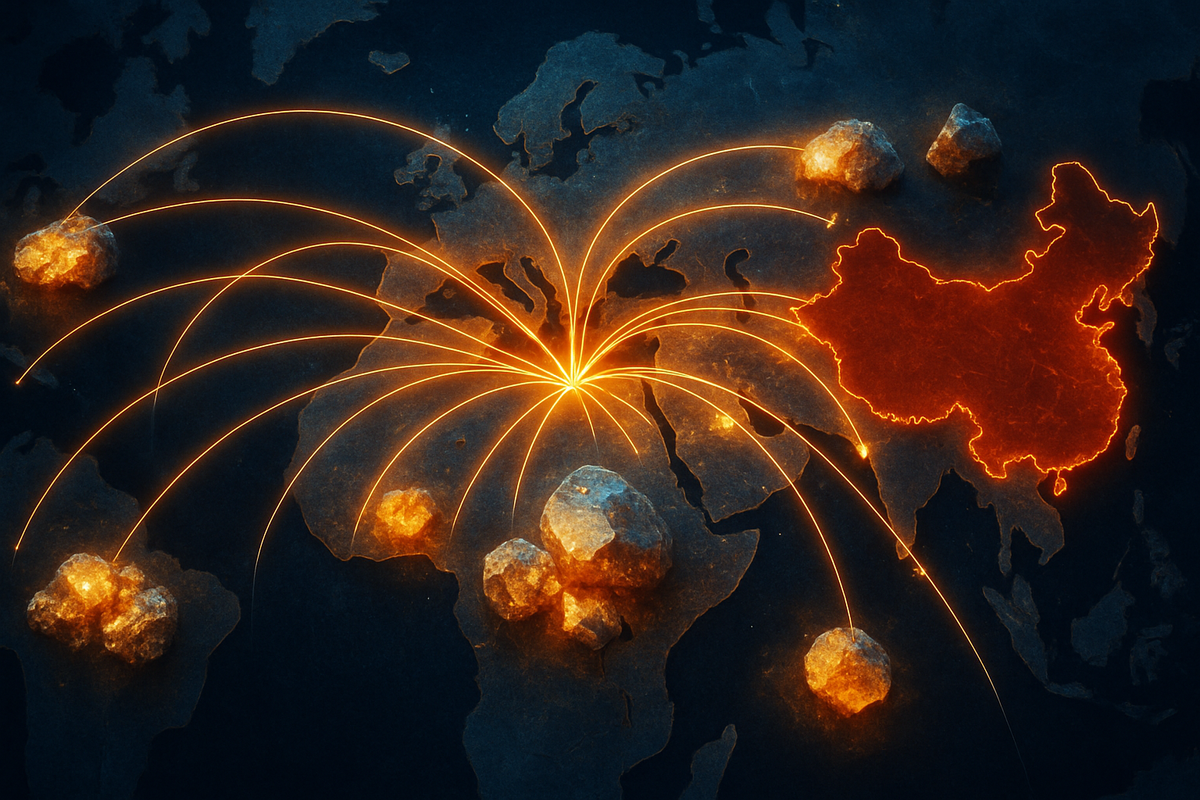Financial News
China Tightens Rare Earth Grip: Global Supply Chains Brace for Impact

Beijing has significantly escalated its control over rare earth exports, implementing stricter regulations that extend beyond raw materials to encompass advanced processing technologies. These new measures, announced by China's Ministry of Commerce (MOFCOM) on October 9, 2025, are poised to send profound ripple effects across global supply chains, particularly impacting the materials sector and high-tech industries in Asia and Europe. Citing national security concerns, China's move is widely perceived as a strategic maneuver in ongoing trade tensions, effectively leveraging its dominant position in the critical minerals market.
The immediate fallout includes heightened uncertainty, significant price volatility for key rare earth elements, and an urgent push for nations worldwide to accelerate efforts in diversifying their critical mineral sources. Industries reliant on these elements—from electric vehicles and renewable energy to advanced semiconductors and defense—are scrambling to assess the implications, facing potential production delays and increased administrative burdens. This strategic tightening of the rare earth spigot underscores a pivotal moment for global manufacturing and geopolitical dynamics, forcing a re-evaluation of supply chain resilience and strategic autonomy.
Beijing's Iron Grip: New Rare Earth Export Controls Send Shockwaves
The comprehensive new regulations unveiled by China on October 9, 2025, represent a substantial expansion of its rare earth export policies, building upon earlier restrictions from April of the same year. These measures are not merely a continuation but an intensification of China's strategic control over the entire rare earth value chain. The scope now extends far beyond the 17 rare earth elements themselves, encompassing advanced processing technologies for minerals, magnet manufacturing, recycling equipment, and the crucial technical know-how associated with these processes. Specifically, high-performance rare earth magnets like neodymium-iron-boron (NdFeB) and samarium-cobalt (SmCo) are under heightened scrutiny, reflecting their critical role in advanced industrial and defense applications.
Beijing's explicit rationale for these restrictions centers on "national security," asserting that certain rare earths and related technologies have been diverted for military or other sensitive uses abroad. This focus has led to a targeted approach: export licenses for overseas defense users are now being denied outright, while applications for materials destined for advanced semiconductors and AI with potential defense applications face rigorous, case-by-case approval processes. A particularly contentious aspect of the new policy is the "0.1% rule," which dictates that overseas entities may require Beijing's approval to export products manufactured abroad if they contain more than 0.1% of Chinese-origin rare earth materials by value per independently usable unit. This unprecedented extraterritorial reach, though its enforcement mechanisms remain unclear, signals a bold assertion of control over global manufacturing processes. While most rules took immediate effect, further material-specific measures are slated for December 1, 2025.
Initial market reactions have been swift and dramatic. Rare earth prices have experienced significant volatility, with reports indicating that dysprosium prices, for instance, have tripled following the announcement. Data also shows a staggering 93% drop in US rare earth shipments from China post-announcement, signaling immediate supply shortages and driving up prices for related commodities globally. Key players involved include China's Ministry of Commerce, which is responsible for implementing these policies, and major rare earth producers within China such as China Northern Rare Earth Group (SSE: 600111) and China Minmetals Rare Earth Co., Ltd. (SHE: 000831). Internationally, companies reliant on these materials, from automotive giants to electronics manufacturers, are the primary stakeholders grappling with the implications. The timeline of events leading to this moment has seen a gradual tightening of Chinese rare earth policies over several years, punctuated by significant restrictions during previous trade disputes, culminating in the current comprehensive and far-reaching controls.
Shifting Fortunes: Companies Poised to Win and Lose
China's escalated rare earth export controls are set to redraw the competitive landscape for numerous public companies, creating distinct winners and losers across the materials, industrial, and technology sectors. Companies with direct exposure to Chinese rare earth imports or those heavily reliant on advanced rare earth magnets for their products are facing significant headwinds, while alternative suppliers and innovators in recycling and substitution technologies stand to gain.
On the losing side, European and Asian high-tech manufacturers are immediately vulnerable. Automotive companies, particularly those focused on electric vehicles (EVs), like Volkswagen (XTRA: VOW3) and Stellantis (NYSE: STLA) in Europe, and Toyota (TYO: 7203) and Hyundai (KRX: 005380) in Asia, rely heavily on rare earth magnets for their motors. Similarly, electronics giants such as Samsung Electronics (KRX: 005930) and Siemens (XTRA: SIE), which use rare earths in everything from smartphones to wind turbines, will experience increased material costs, supply chain disruptions, and potentially longer production cycles. Defense contractors in both regions, including BAE Systems (LON: BA) and Airbus (XTRA: AIR), are particularly hard-hit as direct rare earth material exports for military purposes are now explicitly denied, necessitating rapid and costly overhauls of their strategic sourcing. The "0.1% rule" could also ensnare a wide array of manufacturers, forcing them to seek Beijing's approval for products manufactured outside China, adding layers of complexity and risk.
Conversely, non-Chinese rare earth producers and processors are poised for substantial gains. Companies like Lynas Rare Earths (ASX: LYC) in Australia and MP Materials (NYSE: MP) in the United States, which operate major rare earth mines and processing facilities outside China, are experiencing increased demand and anticipate higher prices for their output. Their strategic importance has surged, attracting greater investment and partnerships as global industries seek diversified and secure supply chains. Emerging players in Canada, Europe, and Africa exploring new rare earth deposits or developing innovative extraction methods, such as Neo Performance Materials (TSX: NEO) with its European processing capabilities, also stand to benefit significantly. Furthermore, companies specializing in rare earth recycling technologies, like Rare Earth Elements (OTCMKTS: REEM) and those developing alternative materials that reduce or eliminate the need for rare earths, will see accelerated investment and market adoption. This shift creates a powerful incentive for innovation in material science and circular economy solutions, offering a lifeline to industries seeking to mitigate China's leverage.
The Broader Geopolitical and Economic Chessboard
China's amplified rare earth export controls are not an isolated event but a significant move within a broader geopolitical and economic chess game. This action fits squarely into a growing trend of nations weaponizing their control over critical raw materials as a tool of foreign policy and economic leverage. It mirrors, in essence, the restrictions placed by Western nations on high-tech exports to China, creating a tit-for-tat dynamic in the global trade arena. The timing, ahead of a potential meeting between President Xi Jinping and President Donald Trump, underscores its role as a strategic bargaining chip, aimed at enhancing China's negotiating position.
The ripple effects of these controls are extensive. Competitors and partners across the globe are being forced into a rapid re-evaluation of their strategic dependencies. For instance, countries in Southeast Asia, which are often part of complex global manufacturing supply chains, may face pressure to choose between adhering to Chinese regulations or aligning with Western efforts to diversify. This could lead to a fragmentation of supply chains and a re-shoring or "friend-shoring" of critical industries, impacting global trade flows and investment patterns. Regulatory and policy implications are profound. In Europe, the urgency to implement the Critical Raw Materials Act has intensified, pushing for accelerated development of domestic mining, processing, recycling, and stockpiling capacities. Similarly, the United States, through initiatives like the Defense Production Act, will likely bolster its efforts to secure domestic rare earth supplies and processing capabilities.
Historically, this situation echoes past resource nationalism movements, such as OPEC's oil embargoes in the 1970s, where control over a vital commodity was used to exert political influence. More recently, China itself has used rare earth export quotas as leverage, notably during a dispute with Japan in 2010, demonstrating a consistent strategy. The current controls are, however, more sophisticated and comprehensive, explicitly targeting advanced technologies and extending their reach extraterritorially. This suggests a long-term strategic play by Beijing to control not just the raw materials but also the intellectual property and manufacturing processes downstream, solidifying its position as an indispensable player in the global high-tech economy. The implications extend beyond economics, touching on national security, technological sovereignty, and the delicate balance of international power.
Navigating the Future: Adaptations and Emerging Opportunities
The intensified rare earth restrictions from China herald a period of significant adaptation and strategic pivots for global industries. In the short term, companies will prioritize securing existing inventories, exploring spot markets, and attempting to fast-track alternative sourcing agreements. However, the true impact will unfold in the long term, necessitating fundamental shifts in global supply chain architecture and technological innovation.
One of the most critical strategic adaptations will be the accelerated development of non-Chinese rare earth supply chains. This includes new mining projects in regions like North America, Australia, and Africa, coupled with significant investments in processing and separation facilities outside China. Countries and corporations will also intensify research into rare earth recycling technologies, aiming to create a circular economy for these vital materials. Furthermore, the push for material substitution—finding alternative materials that can perform the same functions as rare earths—will gain considerable momentum, potentially opening new avenues for material science breakthroughs. This could lead to a decoupling of certain high-tech manufacturing from rare earth dependency, albeit a challenging and long-term endeavor.
Market opportunities will emerge for companies specializing in these alternative supply solutions. Firms involved in advanced recycling, such as those developing innovative magnet-to-magnet recycling processes, will see surging demand and investment. Similarly, companies pioneering new extraction and processing methods that are more environmentally friendly and cost-effective will find a receptive market. Geopolitically, this situation may foster new strategic alliances between resource-rich nations and technology-intensive economies, creating diversified critical mineral partnerships. Potential scenarios range from a continued, highly fragmented global supply chain with regional blocs, to a gradual but significant reduction in China's rare earth dominance over the next decade as alternative sources mature. However, China's established infrastructure and expertise mean it will remain a significant player, albeit one whose leverage may gradually diminish as the world adapts.
A New Era of Resource Geopolitics
China's latest tightening of rare earth export controls marks a definitive turning point in global resource geopolitics, solidifying a new era where critical minerals are explicitly wielded as instruments of national power. The key takeaway is clear: over-reliance on a single source for essential raw materials carries inherent strategic risks, and the global industrial complex is now facing the direct consequences of this vulnerability. This event underscores the urgent need for robust, diversified, and resilient supply chains that can withstand geopolitical pressures.
Moving forward, the market will be characterized by sustained volatility in rare earth prices, driven by supply uncertainty and the slow pace of developing alternative sources. Investors should closely monitor developments in non-Chinese rare earth mining and processing companies, as these are likely to see significant growth and strategic importance. Furthermore, watch for breakthroughs and increased investment in rare earth recycling and substitution technologies, as these represent crucial long-term solutions to mitigate China's influence. The strategic partnerships formed between nations to secure critical mineral supplies will also be a key indicator of future supply chain resilience.
The lasting impact of these controls will likely be a permanent reshaping of global manufacturing strategies, with a greater emphasis on domestic production, "friend-shoring," and technological innovation aimed at reducing critical dependencies. While China's dominant position will not vanish overnight, these actions have galvanized a global effort to build alternative capabilities, setting the stage for a more diversified, albeit potentially more fragmented, critical minerals landscape in the coming decades. The coming months will reveal the true extent of industries' ability to adapt and innovate under these new, challenging conditions.
This content is intended for informational purposes only and is not financial advice
More News
View More




Recent Quotes
View More
Quotes delayed at least 20 minutes.
By accessing this page, you agree to the Privacy Policy and Terms Of Service.



